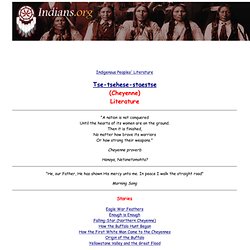

The Original ~ Indians.org. Welcome to the Little Bighorn History Alliance! Little Bighorn History Alliance ~ www.littlebighorn.info. Woman's Cradleboard - Cheyenne Woman's Dress - Southern Cheyenne Woman's Dress - Northern Cheyenne Woman's Leggings - Northern Cheyenne Woman's Leggings - Cheyenne - circa 1880 Woman's Leggings and Moccasins - Northern Cheyenne Woman's Leggings and Moccasins - Cheyenne Woman's Leggings and Moccasins - Southern Cheyenne Woman's Leggings - Northern Cheyenne - circa 1880 Woman's Leggings - Cheyenne - circa 1895 Woman's Leggings - Cheyenne Woman's Leggings - Southern Cheyenne - circa 1890 Woman's Leggings - Southern Cheyenne Woman's Leggings - Southern Cheyenne - circa 1900 Woman's Boot-Style Moccasins - Southern Cheyenne - circa 1915 Woman's Boot-Style Moccasins - Southern Cheyenne Man's Leggings - Northern Cheyenne Man's Leggings - Southern Cheyenne.

Native American Indian Clothing, Beadwork, Weapons. Buffalo Bill Historical Center. Cheyenne Literature. Indigenous Peoples' Literature "A nation is not conquered Until the hearts of its women are on the ground.

Then it is finished, No matter how brave its warriors Or how strong their weapons. " Cheyenne proverb Hanaya, Netonetomohta? "He, our Father, He has shown His mercy unto me. Morning Song Stories Eagle War FeathersEnough is EnoughFalling-Star (Northern Cheyenne)How the Buffalo Hunt BeganHow the First White Man Came to the CheyennesOrigin of the BuffaloYellowstone Valley and the Great Flood The Cheyenne lived in a valley next to a herd of buffalo. The warrior built a smoky fire and turned the beautiful bird over and over in the smoke and this is how we got the CROW. Source: Jack Powell Other Cheyenne Home Pages Cheyenne Warrior (Film by Michael B. Tse-tsehese-staestse (Cheyenne {shy-an'} ) Tse-tsehese-staestse is what the Cheyenne call themselves. The Cheyenne people are the most western branch of the Algonquian people. Cheyenne Council Eric Spotted Elk Cheyenne Lodges Jerome Bushyhead and. NativeNet - Dedicated to literature of Native Americans and Indigenous Peoples.
American-Tribes.com. Crow Indians (Crows) Crow Tribe Where did the name "Crow" come from?

It is a slight mistranslation of the tribe's own name for themselves, Apsaalooke (pronounced opp-sah-loh-kay,) which means "children of the large-beaked bird. " Sometimes you can see the same word spelled Absarokee or Absaroka. Today, Crow people usually use the English name "Crow" themselves. Where do the Crows live? How is the Crow Indian nation organized? What language do the Crows speak? What was Crow culture like in the past? How do Crow Indian children live, and what did they do in the past?
What were Crow men and women's roles? What were Crow homes like in the past? Today, Native Americans only put up a tepee for fun or to connect with their heritage, not for shelter. What was Crow clothing like? Crow Indian leaders sometimes wore the long Indian warbonnets that Plains Indians are famous for. What was Crow transportation like in the days before cars? What was Crow food like in the days before supermarkets? Cheyenne Indians (Cheyennes) Cheyenne Tribe How do you pronounce the word "Cheyenne"?

What does it mean? Cheyenne is pronounced "Shy-ANN. " It comes from the Dakota Sioux name for the Cheyennes, Šahiyenan, which may mean "relatives of the Cree. " The name "Cheyenne" has been spelled many different ways, including Cheyanne, Chyenne, Sheyenne, Sheyanne, and Shyanne. The capital of Wyoming is named after the Cheyenne tribe, and so are the Cheyenne River (in Wyoming and South Dakota) and the Sheyenne River (in North Dakota.)
Where do the Cheyennes live? How is the Cheyenne Indian nation organized? In the past, the Cheyennes were led by a council of 44 chiefs, four from each band. What language do the Cheyennes speak? What was Cheyenne culture like in the past? How do Cheyenne Indian children live, and what did they do in the past?
What were Cheyenne men and women's roles?